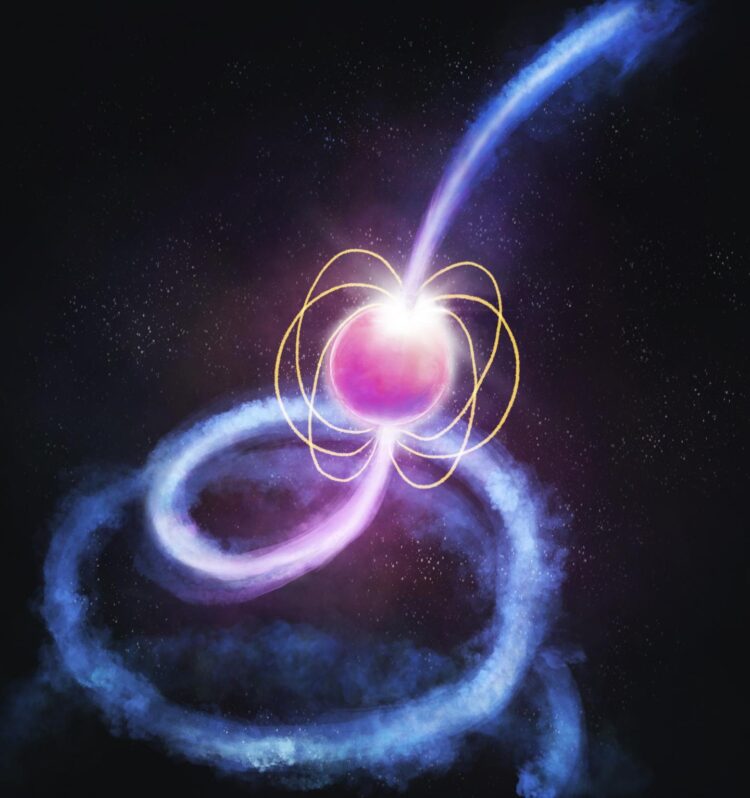
Credit: Credit: ICRAR / Curtin University.
Astronomers have discovered a pulsar–a dense and rapidly spinning neutron star sending radio waves into the cosmos–using a low-frequency radio telescope in outback Australia.
The pulsar was detected with the Murchison Widefield Array (MWA) telescope, in Western Australia’s remote Mid West region.
It’s the first time scientists have discovered a pulsar with the MWA but they believe it will be the first of many.
The finding is a sign of things to come from the multi-billion-dollar Square Kilometre Array (SKA) telescope. The MWA is a precursor telescope for the SKA.
Nick Swainston, a PhD student at the Curtin University node of the International Centre for Radio Astronomy Research (ICRAR), made the discovery while processing data collected as part of an ongoing pulsar survey.
“Pulsars are born as a result of supernovae–when a massive star explodes and dies, it can leave behind a collapsed core known as a neutron star,” he said.
“They’re about one and a half times the mass of the Sun, but all squeezed within only 20 kilometres, and they have ultra-strong magnetic fields.”
Mr Swainston said pulsars spin rapidly and emit electromagnetic radiation from their magnetic poles.
“Every time that emission sweeps across our line of sight, we see a pulse–that’s why we call them pulsars,” he said. “You can imagine it like a giant cosmic lighthouse.”
ICRAR-Curtin astronomer Dr Ramesh Bhat said the newly discovered pulsar is located more than 3000 light-years from Earth and spins about once every second.
“That’s incredibly fast compared to regular stars and planets,” he said. “But in the world of pulsars, it’s pretty normal.”
Dr Bhat said the finding was made using about one per cent of the large volume of data collected for the pulsar survey.
“We’ve only scratched the surface,” he said. “When we do this project at full-scale, we should find hundreds of pulsars in the coming years.”
Pulsars are used by astronomers for several applications including testing the laws of physics under extreme conditions.
“A spoonful of material from a neutron star would weigh millions of tonnes,” Dr Bhat said.
“Their magnetic fields are some of the strongest in the Universe–about 1000 billion times stronger than that we have on Earth.”
“So we can use them to do physics that we can’t do in any of the Earth-based laboratories.”
Finding pulsars and using them for extreme physics is also a key science driver for the SKA telescope.
MWA Director Professor Steven Tingay said the discovery hints at a large population of pulsars awaiting discovery in the Southern Hemisphere.
“This finding is really exciting because the data processing is incredibly challenging, and the results show the potential for us to discover many more pulsars with the MWA and the low-frequency part of the SKA.”
“The study of pulsars is one of the headline areas of science for the multi-billion-dollar SKA, so it is great that our team is at the forefront of this work,” he said.
###
MORE INFORMATION
ICRAR
The International Centre for Radio Astronomy Research (ICRAR) is a joint venture between Curtin University and The University of Western Australia with support and funding from the State Government of Western Australia.
THE MURCHISON WIDEFIELD ARRAY
The Murchison Widefield Array (MWA) is a low-frequency radio telescope and is the first of four Square Kilometre Array (SKA) precursors to be completed. A consortium of partner institutions from seven countries (Australia, USA, India, New Zealand, Canada, Japan, and China) financed the development, construction, commissioning, and operations of the facility. The MWA consortium is led by Curtin University.
PUBLICATION:
‘Discovery of a steep-spectrum low-luminosity pulsar with the Murchison Widefield Array’, published in The Astrophysical Journal Letters on April 21st, 2021.
MULTIMEDIA:
Available from http://www.
CONTACTS:
Dr Ramesh Bhat (ICRAR / Curtin University)
Ph: +61 430 910 055 E: [email protected]
Nick Swainston (ICRAR / Curtin University)
Ph: +61 402 566 321 E: [email protected]
Prof. Steven Tingay (ICRAR / Curtin University)
Ph: +61 401 103 635 E: [email protected]
Kirsten Gottschalk (Media Contact, ICRAR)
Ph: +61 438 361 876 E: [email protected]
Lucien Wilkinson (Media Contact, Curtin University)
Ph: +61 413 070 925 E: [email protected]
Media Contact
Kirsten Gottschalk
[email protected]
Original Source
http://www.
Related Journal Article
http://dx.





